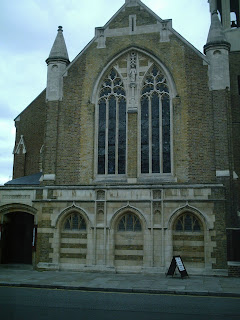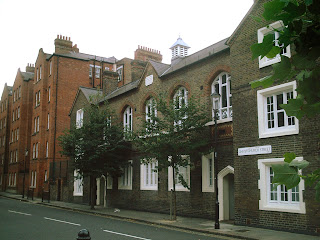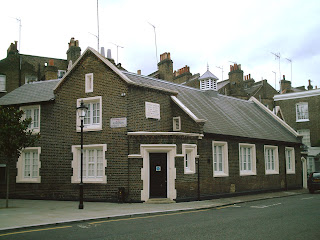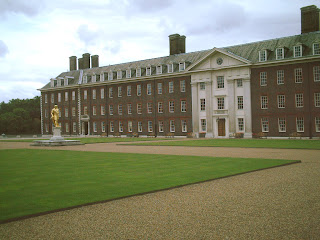Update - Levita House, named after the then chairman of the LCC housing Committee has now been featured as the Twentieth Century Society's Building of the Month for September. http://www.c20society.org.uk/docs/building/0907_ossulston/oss_text.html. Remember you read it here first...

I saw the Church of Scotland Church of St Columba at the end of Pont Street that was the scene of Sapphire’s wedding in AbFab. I’m not totally ignorant of modern cultural references….
My first port of call was the “Cathedral of the Arts and Crafts Movement” Holy Trinity Sloane Street. A church where the sanctuary was alarmed, but the nave was calm and composed. The church was full of Tractarian chairs and the windows were full of William Morris glass to designs by Sir Edward Burne-Jones, the east window being filled with beautiful portraits of saints in glass, a most striking effect. The other windows were in those very strange arts and crafts colours that seem dull and glowing at the same time. The effect is pleasing. Leaving the church I went past the Peter Jones Department Store, an essay in modernism, and walked down the Kings Road, named thus as it was a means for the King to get from London to Hampton Court in the days when this journey was not nearly so easy as it is today.
I would have called into St Luke’s Church but a wedding was either awaited or departing so I did not go in. I didn’t take a photograph either although it would have looked good with the vested clergyperson in front – a reminder of the proper purpose of a church.
Continuing down the King’s Road I went down to the river via Beaufort Street, having had a glimpse into the grounds of the Moravian Church, a dignified protestant denomination who now inhabit Thomas More’s garden.
Beaufort Street has the original Chelsea Council Flats of 1904, all named after dukes. At the end of the street is Crosby Hall.
Crosby Hall has recently been restored, but was transferred to the Embankment in 1910 after standing since 1446 in Bishopsgate. Previously a club for women graduates, it is rumoured that the Crown was offered to Richard III under its roof. Now it appears to be in private hands again, having, since King Richard’s time been a prison, a meeting house, a warehouse, a concert hall and a restaurant.
Next to Crosby Hall is Chelsea Old Church, which was destroyed by bombing in the second world war but was rebuilt. A fine church that saved its chained library and some of its old glass, and these are now within the building. There are decadent sculptures of naked women on the embankment near the church.
Leaving the embankment and walking past Gordon Ramsey™’s restaurant I came to Christ church. Consecrated in 1839 it was built cheaply for £4000, (St Luke’s, built in 1824, cost £40000) to accommodate the servants who were starting to work in the large houses in Chelsea and Belgravia. The church had its own schools for infants and juniors (no seniors in those days). In the church I noticed some stained glass windows behind the font near the door of the church and some marble panels below. A small but pleasant place to worship although I was reminded of Betjeman’s
‘Oh cheerful substitution
Thou varnished pitch-pine’



Forward to the Royal Hospital Chelsea, another place where they sing. Founded by King Charles II and built by Sir Christopher Wren as a response to Les Invalides in Paris I always wonder if that king didn’t just carry on plans that had been made by Cromwell. Kings and rulers come and go but the Civil Service (and the military of course) goes on for ever. It doesn’t seem like a King Charles II gesture to me, as he was more interested in harlotry and vindictiveness than the welfare of the Kingdom. Still the Royal Hospital has considerable accommodation for army pensioners, although rather spartan in contrast to the grand surroundings. There is a little pub for them to socialise in and a dining hall linked to a chapel. The chapel had a rather martial scene of the resurrection painted over the holy table and was comfortably furnished. The dining hall was also homely with some pleasant fixtures. Hope the food’s good for the old soldiers.

The next church I spotted was St Barnabas Pimlico. A forerunner of the Tractarian movement it sported some high gothic art although built too early for Tractarian chairs in the 1840s. The windows were by Kemp with a wheatsheaf on them (I didn’t like to ask if it was part of the Coöperative – sure it wasn’t). Kemp revived the art of stained glass making and to him we owe the stained glass in our more recent churches. There were some beautiful mosaic panels but the main decoration, as is right in ritualist churches, was for the chancel, a place where they sing. The chancel was a riot of colour and pattern on every possible surface. I can’t really do justice to the exuberance of the decoration, including the reredos (six candlesticks), the organ, the floor with its brasses and everything. A glorious church! Then it was time to go home, at least on a high note.


No comments:
Post a Comment